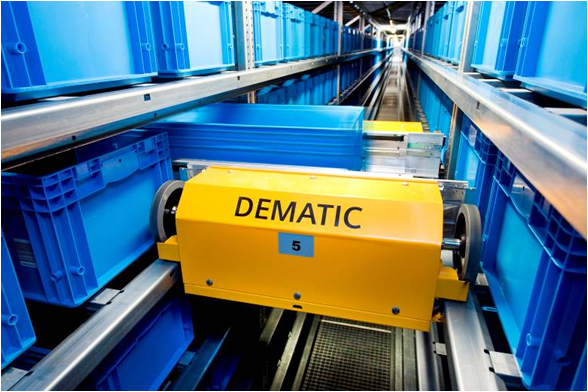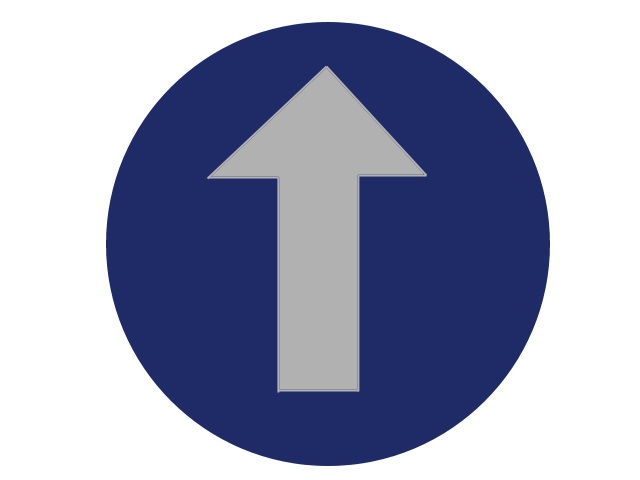|
Supply Chain Digest Blog Entry: April 24, 2013 (here)
I am really excited about the emergence of shuttle technology for semi-automated less than full case (i.e. split case) and/or full case distribution applications. I personally think that this automation technology is really set to take off and I will explain why in this blog entry which provides a primer to explain how this type of solution works. A more in depth and unbiased review of the Dematic Shuttle System can be found here.
First off, the concept of "goods to person" (GTP) means that the warehouse operator is stationary and the material handling equipment brings the goods to the operator. There is a number of different types of solutions that fall into this category including: horizontal and vertical carousels; ASRS miniload systems with extractors; Kiva systems; Swisslog's Autostore system; and shuttle technology. What makes the shuttle unique and exciting is that throughput capabilities have been taken up by an order of magnitude as compared to previous generations of GTP technology. This really opens the doors to apply this type of technology for extremely high volume distribution environments. In a nutshell, here is how it works:
- Incoming goods are transferred from the receiving dock to work stations where operators open master cartons and deposit selling units into standardized totes. Totes are then transferred by conveyors for automatic induction points into a vertical storage buffer (i.e. racking system for totes). Each induction point has a vertical lift that transfers each tote to its vertical storage level within the storage buffer. Storage is typically random since the intent is to workload balance the aisles and levels in the system.
- A storage buffer is essentially a 1-deep or a 2-deep racking system that provides storage for totes (or trays or cases). Each aisle in the system is the width of a shuttle vehicle which is about 38". The shuttle is like a 4-wheeled go-cart that travels back and forth on rails within the level of an aisle within the storage buffer. Thus if the storage buffer has 10 vertical levels of storage then each level can have its own shuttle carrier so that there are 10 vehicles working concurrently within a given operating aisle. This provides a 10-fold higher throughput capacity versus having one ASRS miniload machine working all vertical levels within an aisle - which is why shuttle technology is so exciting. In fact, more than one shuttle carrier can work concurrently within a vertical level hence throughput capacity can be even higher as required.

- When outbound orders are released, the shuttle carriers work within their respective levels to extract totes from their storage locations. The shuttle carrier is equipped with a pair of extractor arms that reach into the storage location to pull the tote/tray/case out of the rack and into its belly. Once the tote is transferred onto the carrier, the carrier travels at speeds of up to 787' feet per minute to a drop-off point at the end of the storage aisle where a vertical lift then takes the tote down to one of several picking work stations. Totes/trays/cases are pulled in the exact sequence that is needed to optimize the needs of the customer orders being processed.
- At the picking work stations which are typically at floor level, operators perform order picking from the incoming product tote to one or multiple orders. The fastest picking productivity is to have one order being picked at a time, but this may not always be practical, so there are multiple configurations that support 6 - 24 orders and even put-walls to be picked concurrently using put-to-light technology. Depending on the configuration, operators can achieve upwards of 400 - 1000 order lines per hour pick rates. Once the product tote is picked, it is pushed off and automatically transferred back into the storage buffer. The next product tote is presented to the operator within 1 second of this transaction. This process is fast, extremely accurate, and ergonomic by design.
- There are companies using this technology to ship 50,000 - 100,000 order per day from a highly densified storage area. What makes this technology appealing is its ability to support very fast order turnaround times for industries where this is a critical requirement.
- Lastly - 3 things that are great about shuttle technology. It is flexible in that the shuttle carriers can work across multiple aisles and vertical levels so that they are NOT captive to an aisle/level. The risk of failure is minimized since a carrier that needs to be maintained or repaired can easily be placed onto the vertical lift and lowered to floor level such that a spare unit can immediately be put into action - no single point of failure. Lastly, no batteries since the system is powered by bus bars. No downtime for battery charging so the system works 7x24x365.
It is interesting to see where this technology is being deployed:
- Manufacturers are storing products into the shuttle system prior to shipping as a means to provide faster order turnaround time thus enabling extended order cutoff times for better customer service.
- Retailers handling high volumes of split case merchandise with the goals to maximize labor productivity and accuracy; and to ensure that the heaviest totes are always sequenced at the bottom of the pallet.
- Distributors seeking to maximize space utilization, efficiency and order fill rates.
- Companies seeking a high security storage environment for products that are of high value or are highly secure (e.g. pharmaceuticals).
- Companies that are dealing with high SKU proliferation and/or high growth rates where there is a need for system scalability since these solutions can easily be expanded in height, length or width. These systems are highly suited to storing hundreds of thousands of small sized SKUs with small inventories.
By the way, this is not bleeding edge technology. The number of shuttle carriers working in the field at the start of 2013 is in the thousands and growing rapidly. So the next time we speak, if you hear me talking with excitement about shuttle technology, now you know why.
Marc Wulfraat is the President of MWPVL International Inc. He can be reached by clicking here. MWPVL International provides supply chain / logistics network strategy consulting services. Our services include: supply chain network strategy; distribution center design; material handling and automation design; supply chain technology consulting; product sourcing; 3PL Outsourcing; and purchasing; transportation consulting; and operational assessments.

|